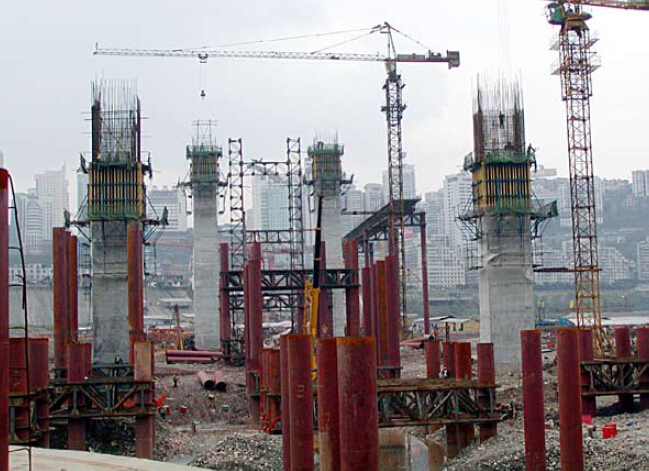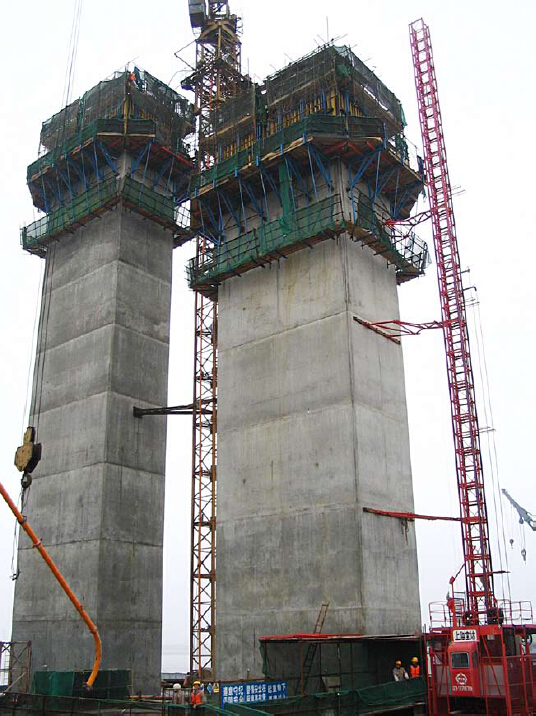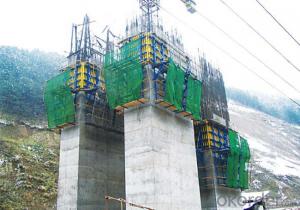Climbing bracket CB240 for formwork and scaffolding system
- Loading Port:
- Tianjin
- Payment Terms:
- TT OR LC
- Min Order Qty:
- 50 m²
- Supply Capability:
- 1000 m²/month
OKorder Service Pledge
OKorder Financial Service
You Might Also Like
Climbing Bracket CB240 & CB210
They are framework brackets for supporting large-area wall formwork.
Typical applications for the CB240&CB210 are pier and column/shear wall/core walll/ in the
building.
CB210 has smaller size than CB240, it will be cost effective in some condition.
Characteristics:
◆ High bearing capacity
The high loading capacity of the brackets allow very large scaffold units. This saves the number
anchor points required as well as reducing climbing times.
◆ Simple moving procedure by crane
Through the strong connection of formwork together with the climbing scaffold, both can be moved
as a single climbing unit by crane. Thus valuable time-savings can be achieved.
◆ Fast striking process without a crane
With the retrusive set, large formwork elements can also be retracted quickly and a minimum of
effort.
◆ Safe with work platform
The platforms have assembled firmly with bracket and will be climbing together, without scaffolding
but can work safely in spite of your high location.


- Q:Can steel formwork be used for both small-scale and large-scale construction projects?
- Yes, steel formwork can be used for both small-scale and large-scale construction projects. Its strength and durability make it suitable for various types of projects, regardless of their size. Additionally, steel formwork offers flexibility and can be easily customized to meet the specific requirements of different construction projects, making it a versatile choice for both small and large-scale construction.
- Q:Are there any specific quality control measures for steel formwork construction?
- Yes, there are specific quality control measures for steel formwork construction. These measures are put in place to ensure that the steel formwork meets the required standards and specifications, and that it is safe and reliable for use in construction projects. One of the main quality control measures is the inspection of the steel formwork materials before they are used. This includes checking for any defects, such as cracks, rust, or other damage, that could affect the integrity and strength of the formwork. The materials should also be checked for proper dimensions and smoothness to ensure they fit together correctly and provide a smooth surface finish. Another quality control measure is the inspection of the steel formwork during and after the construction process. This involves checking that the formwork is properly assembled and secured, with all connections and joints correctly aligned and tightened. The formwork should also be inspected for any signs of deformation, such as bending or twisting, which could compromise its structural integrity. In addition to inspections, quality control measures also involve testing the steel formwork to assess its strength and durability. This can include conducting load tests to determine the maximum load capacity of the formwork, as well as tests to evaluate its resistance to environmental factors such as corrosion, fire, and moisture. Documentation and record-keeping are also important quality control measures for steel formwork construction. This includes maintaining detailed records of inspections, tests, and any repairs or modifications made to the formwork. This documentation ensures that the construction process is traceable and can be audited if necessary. Overall, these quality control measures for steel formwork construction are essential to ensure that the formwork is of high quality, meets the required standards, and provides a safe and reliable support system for concrete during construction.
- Q:How does steel formwork affect the overall cost-effectiveness of a construction project?
- Steel formwork can greatly enhance the overall cost-effectiveness of a construction project in several ways. Firstly, steel formwork is highly durable and reusable, which means it can withstand multiple uses without any significant wear and tear. This reduces the need for frequent replacements, resulting in cost savings in terms of material expenses. Moreover, steel formwork offers excellent dimensional stability, ensuring accurate and precise construction. This eliminates the need for excessive adjustments and rework, saving both time and money. Additionally, the smooth surface finish provided by steel formwork reduces the need for additional plastering or finishing, further reducing construction costs. Furthermore, steel formwork is known for its high strength and load-bearing capacity. This allows for larger spans and fewer support beams, reducing the amount of material required, and consequently reducing costs. The structural integrity and stability of steel formwork also contribute to a reduction in the number of labor hours required for installation and dismantling, resulting in labor cost savings. In terms of time efficiency, steel formwork offers faster assembly and disassembly compared to traditional formwork systems. This can significantly reduce construction durations, leading to cost savings associated with labor, equipment rental, and overhead expenses. Additionally, steel formwork is highly adaptable and versatile, making it suitable for a wide range of construction projects. Its flexibility allows for customization and adjustments as per project requirements, reducing the need for multiple formwork systems for different construction elements. Overall, the utilization of steel formwork in a construction project can contribute to significant cost savings, thanks to its durability, reusability, dimensional accuracy, reduced finishing requirements, material efficiency, time efficiency, and adaptability. It not only minimizes material and labor costs but also enhances productivity, ultimately resulting in improved cost-effectiveness.
- Q:Can steel formwork be used in cold weather conditions?
- Yes, steel formwork can be used in cold weather conditions. Steel is a durable and strong material that can withstand low temperatures without losing its structural integrity. However, it is important to take appropriate precautions such as preventing the steel from coming into direct contact with moisture to avoid potential issues like rusting.
- Q:I was engaged in the patent agency, the two days of receipt of a patent application on the bridge, it is a drawing section map, the other nothing, no label no text, I am on mechanical, civil engineering drawings and utterly ignorant of ah, so simple, later on the Internet for a long time and recall ratio of patent it is unclear whether the drawings, sections of the box girder template, now the goal is clear, but a box girder template knowledge I don't know much about the Internet, did not find out what things, patent is only a few patents, I want to know more about the box girder and box girder template for example, the box girder template with cast-in-place prefabricated, full steel structure, steel wood structure, the hydraulic support system, but also ordinary (the ordinary I don't know what), etc. So, anyway, more detailed information as possible, thank you ~ ~ no more, I don't mind ah, not much, have a point with the province oh
- I am specialized in Civil Engineering (design and construction), you see the drawings are box girder template for the design of template
- Q:Can steel formwork be used for projects with aggressive concrete mixes?
- Yes, steel formwork can be used for projects with aggressive concrete mixes. Steel formwork offers high strength, durability, and resistance to chemical reactions, making it suitable for projects involving aggressive concrete mixes. It can withstand the harsh chemical environment created by aggressive concrete mixes and provide a reliable and long-lasting formwork solution.
- Q:What are the different types of steel used in formwork construction?
- There are several types of steel commonly used in formwork construction, including mild steel, high-strength low-alloy steel (HSLA), and high-strength steel. Additionally, stainless steel may be utilized in specific applications where corrosion resistance is required. The choice of steel type depends on factors such as the desired strength, durability, and cost-effectiveness of the formwork system.
- Q:What are the considerations when designing steel formwork for stairs?
- When designing steel formwork for stairs, several important considerations need to be taken into account. Firstly, the structural integrity and load-bearing capacity of the formwork must be carefully evaluated to ensure it can support the weight of workers, materials, and any equipment used during the construction process. Additionally, the formwork should be designed to provide sufficient stability and rigidity to prevent any deformation or movement during concrete pouring and curing. The dimensions and shape of the stairs, including the riser and tread dimensions, should be accurately calculated to meet safety and accessibility standards. Lastly, attention should be given to ease of assembly, disassembly, and reusability of the formwork to optimize efficiency and cost-effectiveness in construction projects.
- Q:What are the advantages of using steel formwork?
- There are several advantages of using steel formwork in construction projects. Firstly, steel formwork is highly durable and has a longer lifespan compared to other materials such as timber or plywood. This means that it can be reused multiple times, reducing the overall cost of construction. Additionally, steel formwork is resistant to warping, shrinking, or expanding due to changes in humidity or temperature, ensuring consistent and accurate results in the construction process. Secondly, steel formwork offers excellent strength and stability, making it ideal for constructing large or complex structures. Its rigidity minimizes the risk of deformations and ensures the structural integrity of the concrete during the pouring and curing process, resulting in a high-quality finish. Furthermore, steel formwork provides a smooth and consistent surface finish to the concrete. This is particularly advantageous for architectural projects where an aesthetic appearance is essential. The steel surface prevents leakage, minimizing the need for additional waterproofing measures and reducing the risk of defects or cracks in the concrete. Moreover, steel formwork is highly adaptable and can be easily customized to fit different shapes and sizes. This flexibility allows for the construction of unique and complex designs, providing architects and engineers with more freedom in their creative process. Lastly, steel formwork is time-efficient. Its modular nature and ease of assembly and dismantling enable faster construction cycles, reducing overall project timelines. The quick turnaround time translates into cost savings and increased productivity on the construction site. In conclusion, the advantages of using steel formwork include durability, strength, smooth surface finish, adaptability, and time-efficiency. These benefits make steel formwork a preferred choice in construction projects, improving construction quality, reducing costs, and enhancing overall efficiency.
- Q:Can steel formwork be used for water tanks or swimming pools?
- Yes, steel formwork can be used for water tanks or swimming pools. Steel formwork is highly durable and can withstand the pressure exerted by the water. It provides a strong structure for the tank or pool, ensuring stability and longevity. Additionally, steel formwork allows for flexibility in design and can be easily customized to meet specific project requirements.
1. Manufacturer Overview |
|
|---|---|
| Location | |
| Year Established | |
| Annual Output Value | |
| Main Markets | |
| Company Certifications | |
2. Manufacturer Certificates |
|
|---|---|
| a) Certification Name | |
| Range | |
| Reference | |
| Validity Period | |
3. Manufacturer Capability |
|
|---|---|
| a)Trade Capacity | |
| Nearest Port | |
| Export Percentage | |
| No.of Employees in Trade Department | |
| Language Spoken: | |
| b)Factory Information | |
| Factory Size: | |
| No. of Production Lines | |
| Contract Manufacturing | |
| Product Price Range | |
Send your message to us
Climbing bracket CB240 for formwork and scaffolding system
- Loading Port:
- Tianjin
- Payment Terms:
- TT OR LC
- Min Order Qty:
- 50 m²
- Supply Capability:
- 1000 m²/month
OKorder Service Pledge
OKorder Financial Service
Similar products
New products
Hot products

























